Okinawan vs Ethiopian Community Comparison
COMPARE
Okinawan
Ethiopian
Social Comparison
Social Comparison
Okinawans
Ethiopians
8,907
SOCIAL INDEX
86.5/ 100
SOCIAL RATING
39th/ 347
SOCIAL RANK
7,266
SOCIAL INDEX
70.1/ 100
SOCIAL RATING
126th/ 347
SOCIAL RANK
Ethiopian Integration in Okinawan Communities
The statistical analysis conducted on geographies consisting of 62,100,798 people shows a mild positive correlation between the proportion of Ethiopians within Okinawan communities in the United States with a correlation coefficient (R) of 0.380. On average, for every 1% (one percent) increase in Okinawans within a typical geography, there is an increase of 0.769% in Ethiopians. To illustrate, in a geography comprising of 100,000 individuals, a rise of 1,000 Okinawans corresponds to an increase of 769.0 Ethiopians.
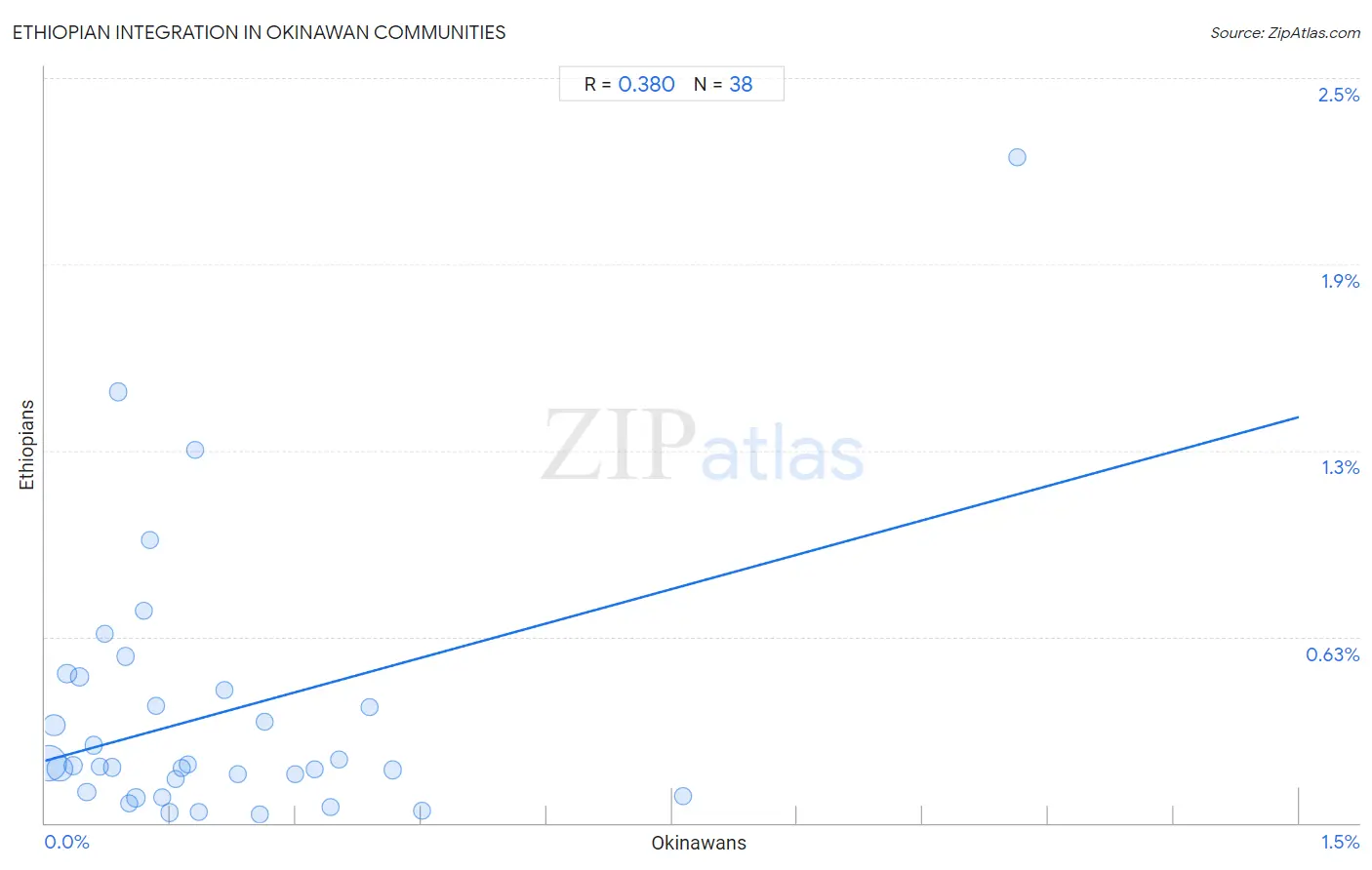
Okinawan vs Ethiopian Income
When considering income, the most significant differences between Okinawan and Ethiopian communities in the United States are seen in wage/income gap (28.1% compared to 21.8%, a difference of 28.8%), householder income ages 25 - 44 years ($119,349 compared to $96,824, a difference of 23.3%), and householder income ages 45 - 64 years ($124,796 compared to $103,736, a difference of 20.3%). Conversely, both communities are more comparable in terms of householder income under 25 years ($54,701 compared to $53,818, a difference of 1.6%), median female earnings ($46,905 compared to $43,243, a difference of 8.5%), and householder income over 65 years ($70,846 compared to $64,989, a difference of 9.0%).

| Income Metric | Okinawan | Ethiopian |
| Per Capita Income | Exceptional $55,817 | Exceptional $46,569 |
| Median Family Income | Exceptional $129,979 | Exceptional $108,251 |
| Median Household Income | Exceptional $106,624 | Exceptional $89,640 |
| Median Earnings | Exceptional $57,550 | Exceptional $49,572 |
| Median Male Earnings | Exceptional $67,232 | Excellent $56,243 |
| Median Female Earnings | Exceptional $46,905 | Exceptional $43,243 |
| Householder Age | Under 25 years | Exceptional $54,701 | Exceptional $53,818 |
| Householder Age | 25 - 44 years | Exceptional $119,349 | Good $96,824 |
| Householder Age | 45 - 64 years | Exceptional $124,796 | Excellent $103,736 |
| Householder Age | Over 65 years | Exceptional $70,846 | Exceptional $64,989 |
| Wage/Income Gap | Tragic 28.1% | Exceptional 21.8% |
Okinawan vs Ethiopian Poverty
When considering poverty, the most significant differences between Okinawan and Ethiopian communities in the United States are seen in child poverty among girls under 16 (13.0% compared to 16.5%, a difference of 26.5%), child poverty under the age of 16 (13.1% compared to 16.3%, a difference of 24.4%), and child poverty under the age of 5 (13.4% compared to 16.5%, a difference of 23.0%). Conversely, both communities are more comparable in terms of seniors poverty over the age of 75 (12.1% compared to 11.8%, a difference of 2.5%), seniors poverty over the age of 65 (10.4% compared to 10.7%, a difference of 3.3%), and female poverty among 18-24 year olds (20.8% compared to 20.2%, a difference of 3.3%).
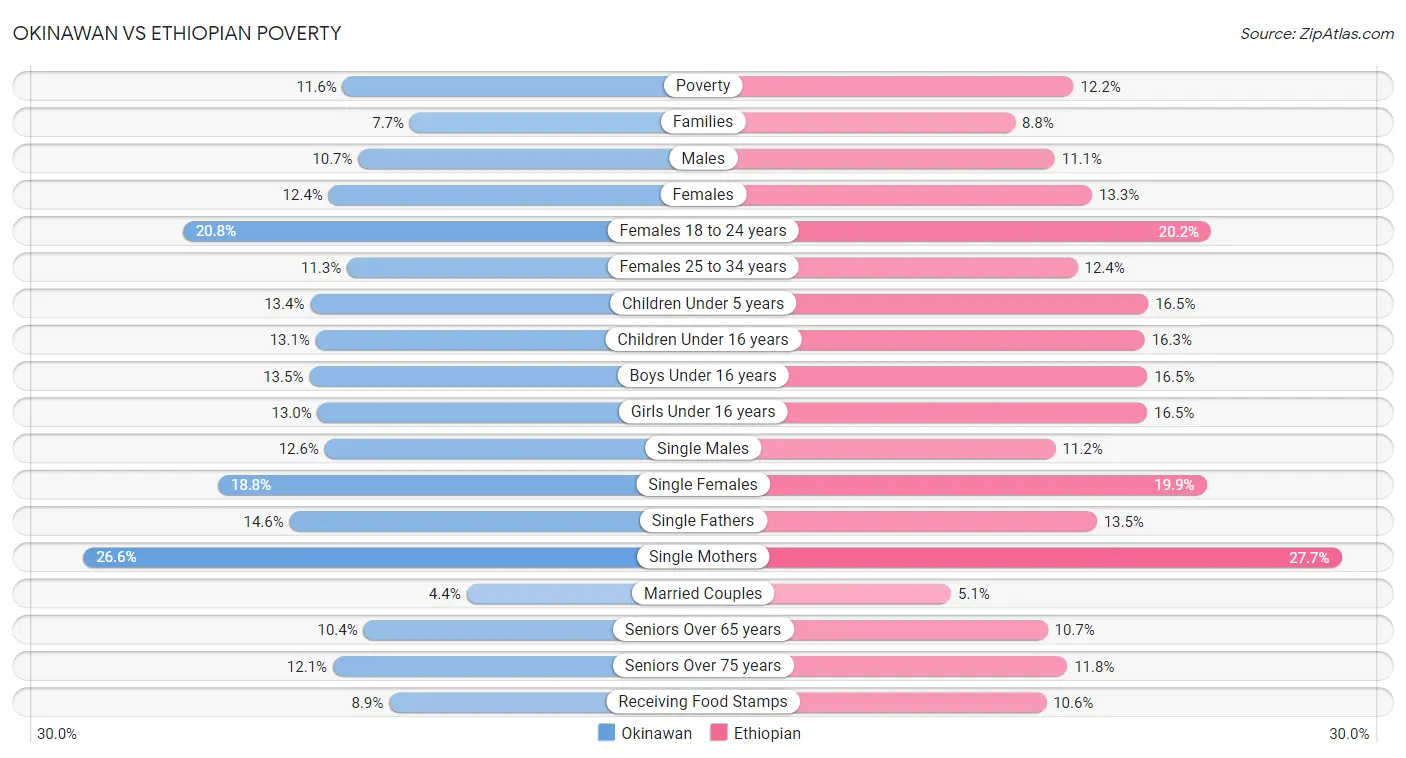
| Poverty Metric | Okinawan | Ethiopian |
| Poverty | Exceptional 11.6% | Average 12.2% |
| Families | Exceptional 7.7% | Good 8.8% |
| Males | Excellent 10.7% | Average 11.1% |
| Females | Exceptional 12.4% | Good 13.3% |
| Females 18 to 24 years | Tragic 20.8% | Average 20.2% |
| Females 25 to 34 years | Exceptional 11.3% | Exceptional 12.4% |
| Children Under 5 years | Exceptional 13.4% | Excellent 16.5% |
| Children Under 16 years | Exceptional 13.1% | Average 16.3% |
| Boys Under 16 years | Exceptional 13.5% | Average 16.5% |
| Girls Under 16 years | Exceptional 13.0% | Average 16.5% |
| Single Males | Good 12.6% | Exceptional 11.2% |
| Single Females | Exceptional 18.8% | Exceptional 19.9% |
| Single Fathers | Exceptional 14.6% | Exceptional 13.5% |
| Single Mothers | Exceptional 26.6% | Exceptional 27.7% |
| Married Couples | Exceptional 4.4% | Good 5.1% |
| Seniors Over 65 years | Exceptional 10.4% | Good 10.7% |
| Seniors Over 75 years | Average 12.1% | Excellent 11.8% |
| Receiving Food Stamps | Exceptional 8.9% | Exceptional 10.6% |
Okinawan vs Ethiopian Unemployment
When considering unemployment, the most significant differences between Okinawan and Ethiopian communities in the United States are seen in unemployment among women with children ages 6 to 17 years (7.0% compared to 9.0%, a difference of 27.9%), unemployment among women with children under 6 years (5.8% compared to 6.8%, a difference of 16.3%), and unemployment among women with children under 18 years (4.7% compared to 5.3%, a difference of 12.2%). Conversely, both communities are more comparable in terms of unemployment among ages 30 to 34 years (4.8% compared to 4.9%, a difference of 0.71%), male unemployment (5.1% compared to 5.1%, a difference of 0.82%), and unemployment among ages 60 to 64 years (4.7% compared to 4.7%, a difference of 1.1%).
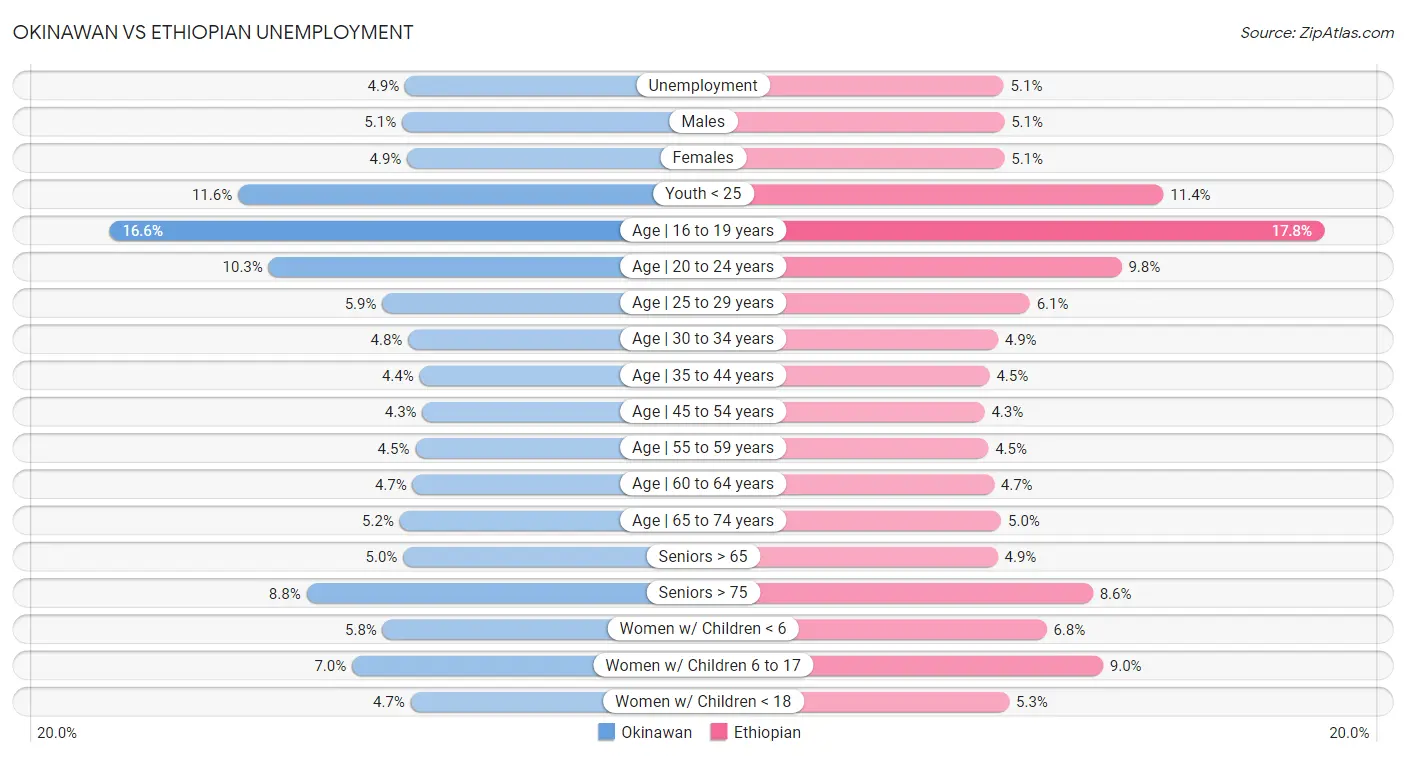
| Unemployment Metric | Okinawan | Ethiopian |
| Unemployment | Exceptional 4.9% | Excellent 5.1% |
| Males | Exceptional 5.1% | Exceptional 5.1% |
| Females | Exceptional 4.9% | Excellent 5.1% |
| Youth < 25 | Average 11.6% | Excellent 11.4% |
| Age | 16 to 19 years | Exceptional 16.6% | Fair 17.8% |
| Age | 20 to 24 years | Fair 10.3% | Exceptional 9.8% |
| Age | 25 to 29 years | Exceptional 5.9% | Exceptional 6.1% |
| Age | 30 to 34 years | Exceptional 4.8% | Exceptional 4.9% |
| Age | 35 to 44 years | Exceptional 4.4% | Excellent 4.5% |
| Age | 45 to 54 years | Exceptional 4.3% | Exceptional 4.3% |
| Age | 55 to 59 years | Exceptional 4.5% | Exceptional 4.5% |
| Age | 60 to 64 years | Exceptional 4.7% | Exceptional 4.7% |
| Age | 65 to 74 years | Exceptional 5.2% | Exceptional 5.0% |
| Seniors > 65 | Exceptional 5.0% | Exceptional 4.9% |
| Seniors > 75 | Fair 8.8% | Good 8.6% |
| Women w/ Children < 6 | Exceptional 5.8% | Exceptional 6.8% |
| Women w/ Children 6 to 17 | Exceptional 7.0% | Fair 9.0% |
| Women w/ Children < 18 | Exceptional 4.7% | Excellent 5.3% |
Okinawan vs Ethiopian Labor Participation
When considering labor participation, the most significant differences between Okinawan and Ethiopian communities in the United States are seen in in labor force | age 16-19 (32.8% compared to 38.2%, a difference of 16.6%), in labor force | age 20-24 (72.7% compared to 77.3%, a difference of 6.3%), and in labor force | age > 16 (65.9% compared to 69.3%, a difference of 5.1%). Conversely, both communities are more comparable in terms of in labor force | age 25-29 (85.2% compared to 86.2%, a difference of 1.1%), in labor force | age 35-44 (84.5% compared to 85.9%, a difference of 1.7%), and in labor force | age 45-54 (83.0% compared to 84.8%, a difference of 2.1%).

| Labor Participation Metric | Okinawan | Ethiopian |
| In Labor Force | Age > 16 | Exceptional 65.9% | Exceptional 69.3% |
| In Labor Force | Age 20-64 | Good 79.6% | Exceptional 82.0% |
| In Labor Force | Age 16-19 | Tragic 32.8% | Exceptional 38.2% |
| In Labor Force | Age 20-24 | Tragic 72.7% | Exceptional 77.3% |
| In Labor Force | Age 25-29 | Exceptional 85.2% | Exceptional 86.2% |
| In Labor Force | Age 30-34 | Average 84.6% | Exceptional 86.6% |
| In Labor Force | Age 35-44 | Good 84.5% | Exceptional 85.9% |
| In Labor Force | Age 45-54 | Good 83.0% | Exceptional 84.8% |
Okinawan vs Ethiopian Family Structure
When considering family structure, the most significant differences between Okinawan and Ethiopian communities in the United States are seen in single father households (1.9% compared to 2.4%, a difference of 29.9%), single mother households (5.0% compared to 6.5%, a difference of 29.5%), and divorced or separated (10.5% compared to 12.0%, a difference of 14.8%). Conversely, both communities are more comparable in terms of family households with children (27.2% compared to 27.6%, a difference of 1.7%), family households (62.5% compared to 61.2%, a difference of 2.0%), and average family size (3.15 compared to 3.24, a difference of 2.8%).

| Family Structure Metric | Okinawan | Ethiopian |
| Family Households | Tragic 62.5% | Tragic 61.2% |
| Family Households with Children | Poor 27.2% | Good 27.6% |
| Married-couple Households | Exceptional 47.4% | Tragic 43.2% |
| Average Family Size | Tragic 3.15 | Good 3.24 |
| Single Father Households | Exceptional 1.9% | Poor 2.4% |
| Single Mother Households | Exceptional 5.0% | Fair 6.5% |
| Currently Married | Excellent 47.4% | Tragic 44.5% |
| Divorced or Separated | Exceptional 10.5% | Average 12.0% |
| Births to Unmarried Women | Exceptional 26.9% | Exceptional 29.8% |
Okinawan vs Ethiopian Vehicle Availability
When considering vehicle availability, the most significant differences between Okinawan and Ethiopian communities in the United States are seen in no vehicles in household (14.1% compared to 10.5%, a difference of 34.4%), 4 or more vehicles in household (5.5% compared to 5.8%, a difference of 4.7%), and 1 or more vehicles in household (86.1% compared to 89.6%, a difference of 4.0%). Conversely, both communities are more comparable in terms of 3 or more vehicles in household (17.4% compared to 17.9%, a difference of 2.5%), 2 or more vehicles in household (51.2% compared to 53.1%, a difference of 3.7%), and 1 or more vehicles in household (86.1% compared to 89.6%, a difference of 4.0%).

| Vehicle Availability Metric | Okinawan | Ethiopian |
| No Vehicles Available | Tragic 14.1% | Average 10.5% |
| 1+ Vehicles Available | Tragic 86.1% | Average 89.6% |
| 2+ Vehicles Available | Tragic 51.2% | Tragic 53.1% |
| 3+ Vehicles Available | Tragic 17.4% | Tragic 17.9% |
| 4+ Vehicles Available | Tragic 5.5% | Tragic 5.8% |
Okinawan vs Ethiopian Education Level
When considering education level, the most significant differences between Okinawan and Ethiopian communities in the United States are seen in doctorate degree (3.3% compared to 2.3%, a difference of 39.6%), professional degree (7.3% compared to 5.4%, a difference of 36.6%), and no schooling completed (1.8% compared to 2.4%, a difference of 31.5%). Conversely, both communities are more comparable in terms of nursery school (98.2% compared to 97.6%, a difference of 0.58%), kindergarten (98.2% compared to 97.6%, a difference of 0.58%), and 2nd grade (98.1% compared to 97.5%, a difference of 0.58%).
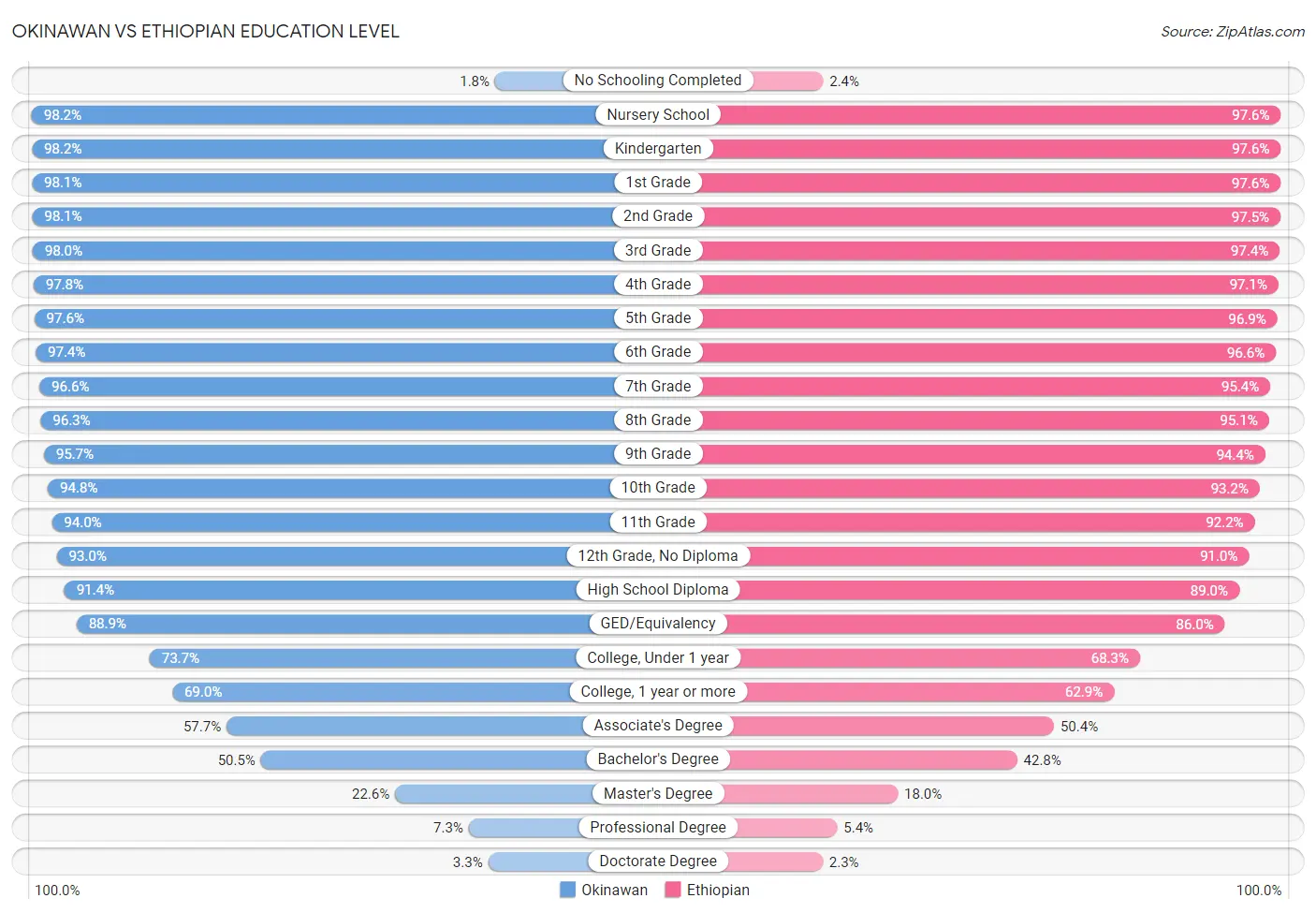
| Education Level Metric | Okinawan | Ethiopian |
| No Schooling Completed | Exceptional 1.8% | Tragic 2.4% |
| Nursery School | Exceptional 98.2% | Tragic 97.6% |
| Kindergarten | Exceptional 98.2% | Tragic 97.6% |
| 1st Grade | Exceptional 98.1% | Tragic 97.6% |
| 2nd Grade | Exceptional 98.1% | Tragic 97.5% |
| 3rd Grade | Exceptional 98.0% | Tragic 97.4% |
| 4th Grade | Exceptional 97.8% | Tragic 97.1% |
| 5th Grade | Exceptional 97.6% | Tragic 96.9% |
| 6th Grade | Exceptional 97.4% | Tragic 96.6% |
| 7th Grade | Exceptional 96.6% | Tragic 95.4% |
| 8th Grade | Exceptional 96.3% | Tragic 95.1% |
| 9th Grade | Exceptional 95.7% | Tragic 94.4% |
| 10th Grade | Exceptional 94.8% | Tragic 93.2% |
| 11th Grade | Exceptional 94.0% | Poor 92.2% |
| 12th Grade, No Diploma | Exceptional 93.0% | Fair 91.0% |
| High School Diploma | Exceptional 91.4% | Fair 89.0% |
| GED/Equivalency | Exceptional 88.9% | Good 86.0% |
| College, Under 1 year | Exceptional 73.7% | Exceptional 68.3% |
| College, 1 year or more | Exceptional 69.0% | Exceptional 62.9% |
| Associate's Degree | Exceptional 57.7% | Exceptional 50.4% |
| Bachelor's Degree | Exceptional 50.5% | Exceptional 42.8% |
| Master's Degree | Exceptional 22.6% | Exceptional 18.0% |
| Professional Degree | Exceptional 7.3% | Exceptional 5.4% |
| Doctorate Degree | Exceptional 3.3% | Exceptional 2.3% |
Okinawan vs Ethiopian Disability
When considering disability, the most significant differences between Okinawan and Ethiopian communities in the United States are seen in disability age 35 to 64 (9.4% compared to 10.5%, a difference of 11.7%), vision disability (1.8% compared to 2.0%, a difference of 11.2%), and disability age 65 to 74 (20.7% compared to 22.7%, a difference of 9.6%). Conversely, both communities are more comparable in terms of self-care disability (2.2% compared to 2.2%, a difference of 0.17%), disability age under 5 (1.1% compared to 1.1%, a difference of 0.32%), and cognitive disability (17.6% compared to 17.9%, a difference of 1.9%).
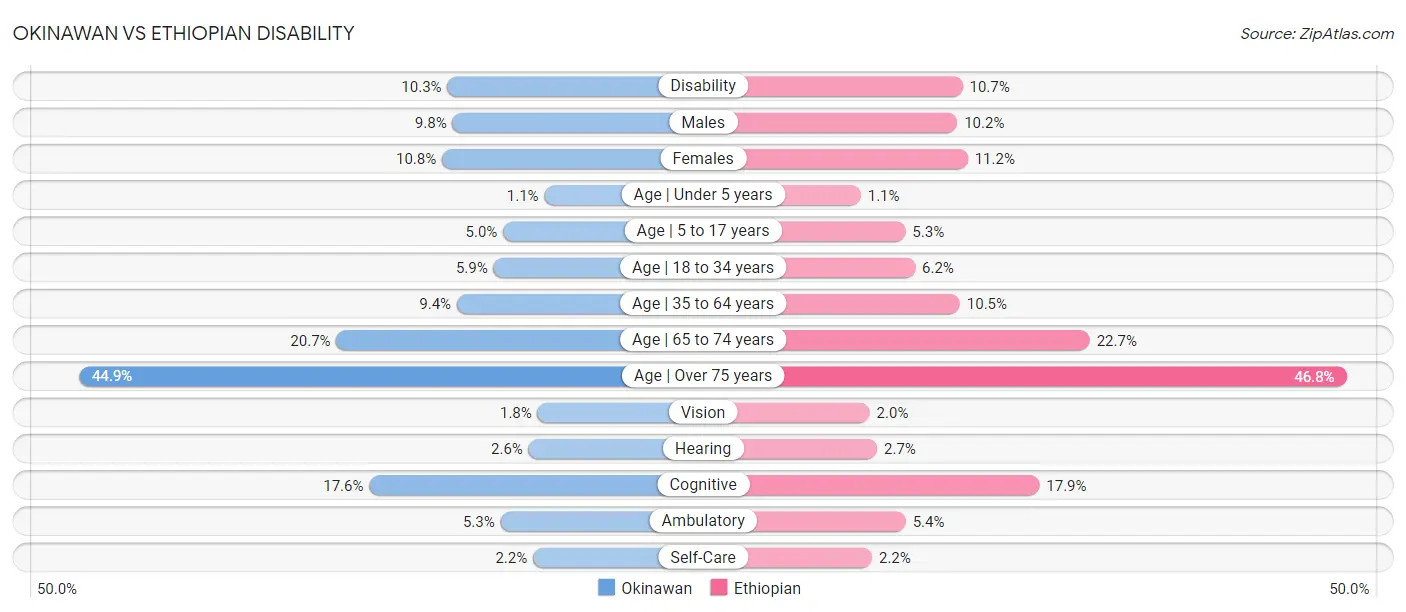
| Disability Metric | Okinawan | Ethiopian |
| Disability | Exceptional 10.3% | Exceptional 10.7% |
| Males | Exceptional 9.8% | Exceptional 10.2% |
| Females | Exceptional 10.8% | Exceptional 11.2% |
| Age | Under 5 years | Exceptional 1.1% | Exceptional 1.1% |
| Age | 5 to 17 years | Exceptional 5.0% | Exceptional 5.3% |
| Age | 18 to 34 years | Exceptional 5.9% | Exceptional 6.2% |
| Age | 35 to 64 years | Exceptional 9.4% | Exceptional 10.5% |
| Age | 65 to 74 years | Exceptional 20.7% | Excellent 22.7% |
| Age | Over 75 years | Exceptional 44.9% | Excellent 46.8% |
| Vision | Exceptional 1.8% | Exceptional 2.0% |
| Hearing | Exceptional 2.6% | Exceptional 2.7% |
| Cognitive | Tragic 17.6% | Tragic 17.9% |
| Ambulatory | Exceptional 5.3% | Exceptional 5.4% |
| Self-Care | Exceptional 2.2% | Exceptional 2.2% |